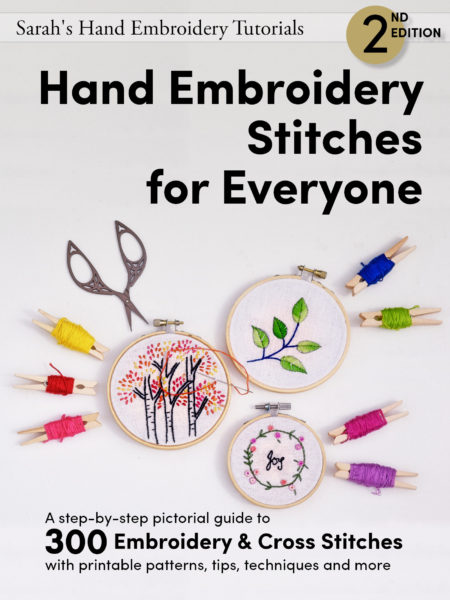
Convent Stitch is also known as
Nun’s Stitch [EN], Klosterstich [DE].
About the Convent Stitch
Convent Stitch was mostly used by the nuns in Germany’s convents during the 14th and 15th centuries. It was used to create elaborate wall hangings on linen with woolen thread. This stitch focuses just on filling in the patterns quickly. So, the couching threads are not intended to make any pattern but are supposed to be as short as possible to keep them ‘invisible.’ In the Convent Stitch, the couching threads and the laid thread are of the same color. So, the laid threads are couched down using the same continuous thread that was used to lay.
How to do the Convent Stitch
Let’s work on a triangle pattern to make it clearer. This stitch is an excellent way of filling larger areas of patterns.
 |  |
| Fig 1: Start by laying a thread by coming out from point A and going in through B, two points at the end of the broader side of the pattern. | Fig 2: Use the same thread to come out from a point on the lower side of the laid thread and anchoring it with a small stitch, as shown. |
 |  |
| Fig 3: Again, come out at another location on the laid thread and anchor down as shown. This time, I came out from the top side of the laid thread, but you can come out from the lower side as before. | Fig 4: Once you finish one row, continue with the same thread and lay down the stitch C-D, as shown. The earlier stitch A-B has three stitches that are holding it down. |
 |  |
| Fig 5: Start couching C-D as you had couched A-B. You can anchor the threads down at a location of your choice- we are not following any pattern here. | Fig 6: A finished pattern looks like this. It looks filled with no much notice going on to the Couching Stitches. |
Learn to do Convent Stitch in 2 minutes!
Related projects
Learn 306 stitches and find many more guided patterns in 600-page eBook!
Other Stitches from the Couching Stitch Family
Bokhara Couching |
Trellis Couching | |
Lattice Couching |
Twisted Lattice | |
Torocko Stitch | ||
Honeycomb Filling |
Battlement Couching |
Bayeux Stitch |
Persian Border |
Tuft Couching |



![Couching [EN], Punto de bolonia [ES], Point de Boulogne [FR], Klosterstich [DE], Punto Bologna [IT], Ponto de bolonha [PT]](https://www.embroidery.rocksea.org/images/embroidery/surface_couching_index_2.jpg)




![Nun’s Stitch [EN], Klosterstich [DE]](https://www.embroidery.rocksea.org/images/embroidery/convent_stitch_index_2.jpg)




![Point de jacobin [FR]](https://www.embroidery.rocksea.org/images/embroidery/jacobean_index_2.jpg)
















Sorry to be a pedant, but this isn’t a klosterstitch. Klosterstitch is made by having the short, straight couching stitch to the back of the embroidery, with the long, slanted stitch to the front. The couching is slanted in the direction of the twist of the thread, so that it will blend in. The stitch was done like that so that the nuns doing the embroidery wouldn’t be wasting expensive thread on areas that wouldn’t be seen, whereas the way you did it will have almost as much thread on the back. This is a good tutorial on couching, though
Thank you, Serena. I appreciate your input. I do see your point about having more thread show on the side that is visible. It does make sense! I should check back on what I researched and make the corrections.
BEAUTIFUL!
Thanks, Monica.🙂
This seems handy for filling in. I don’t have much experiencing with couching, but you have certainly inspired me to give it a try!! As always, thank you for your great tutorials and ideas. I also really enjoyed the historical background on the stitch!
Thank you. ❤️I am so glad to hear that our pages have inspired you. Enjoy stitching!
I have just tried a sample of this new stitch and already fallen in love with it Thank you. Always a thrill to learn a new stitch. Looking forward to using this stitch with it’s more textured look for filling in.
Wow, thanks, Ann! So happy that you liked this stitch. I will be posting a pattern soon to apply this stitch too. 🙂
Great , will look forward to that.
Your tutorials are always so clear and easy to understand. I appreciate how much time goes into these. I spend most of my time quilting, buy you make me want to try every one of these stitches. Do you have any advice on how to make more time in a day?
One of these days I am going to make a quilt that is covered with all the beautiful stitches I learned from you.
Brita
Thank you so much, Brita. Kind words like yours really do keep us encouraged.
I have noticed that most women like to stitch after their work and day’s chores. They find stitching relaxing, and spending an hour or so before retiring to bed works the best. It is also time when the rest of the house is silent, and we can be just left to ourselves. Do you think it will work for you? Just make sure you are sitting in a well-lit place. 🙂
Doing a quilt with all these stitches is a great idea. In fact, I was designing a project of making patches of stitches for quilting. If I ever succeed in finishing it, you can look at it for ideas or templates.